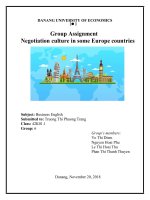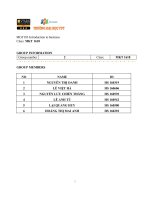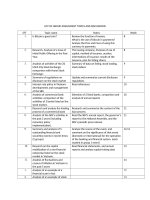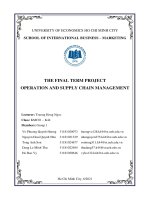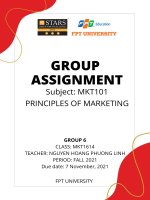mkt201 group assignment cocacola
Bạn đang xem bản rút gọn của tài liệu. Xem và tải ngay bản đầy đủ của tài liệu tại đây (5.7 MB, 30 trang )
<span class="text_page_counter">Trang 2</span><div class="page_container" data-page="2">
2. COCACOLA Vietnam :...
</div><span class="text_page_counter">Trang 3</span><div class="page_container" data-page="3">1. Short profile of the
product :...4
2. Target customer and target
market :...5a.
Market :...5
b.
Customers :...6
3. Analysis about the Consumer Behavior and current 4Ps
</div><span class="text_page_counter">Trang 4</span><div class="page_container" data-page="4">Marketing
strategy :...7a) Analysis about the Consumer Behavior :...7
b) 4Ps Marketing
strategy :...9
-Price :...10
</div><span class="text_page_counter">Trang 5</span><div class="page_container" data-page="5">-Place :...10
-Promotion :...11
SUGGESTIONS AND
1.
Suggestions :...12
</div><span class="text_page_counter">Trang 6</span><div class="page_container" data-page="6">1. COCACOLA Global :...
...3
</div><span class="text_page_counter">Trang 8</span><div class="page_container" data-page="8">b.
Customers :...6
3. Analysis about the Consumer Behavior and current 4Ps
Marketing
strategy :...7a) Analysis about the Consumer Behavior :...7
b) 4Ps Marketing
strategy :...9
</div><span class="text_page_counter">Trang 9</span><div class="page_container" data-page="9">-Price :...10
-Place :...10
-Promotion :...11
</div><span class="text_page_counter">Trang 10</span><div class="page_container" data-page="10">2. Conclusion:...
Table of Contents
</div><span class="text_page_counter">Trang 11</span><div class="page_container" data-page="11">I. Present a brief introduction on the brand. Who are the brand's targetconsumers? Develop a consumer persona for each target segment of the brand.1. Introduction:
a. Coca-Cola Global: b. Coca-Cola Vietnam:2. Brand's target consumers:3. Develop a consumer personal
II. What are the internal influences on the behavior of the brand's targetconsumers?
III. What are the external influences on the behavior of the brand's targetconsumers?
IV. How do these internal and external factors shape the behavior and impact thedecision-making process of these consumers?
V. What are the marketing implications for the company? How can the companyuse this new knowledge in their efforts to connect and build relationships withconsumers?
</div><span class="text_page_counter">Trang 12</span><div class="page_container" data-page="12">I. Present a brief introduction on the brand. Who are the brand's targetconsumers? Develop a consumer persona for each target segment of thebrand.
1. INTRODUCTION:a. Coca-Cola Global:
The Coca-Cola Company which is headquartered in Atlanta, Georgia, was founded inWilmington, Delaware, is a beverage company and is the manufacturer, retailer, promote USmultinational nonalcoholic beverages and syrups. The company is best known for its flagshipproduct Coca-Cola, which was invented in 1886 by pharmacist John Stith Pemberton inColumbus, Georgia. Formulas and brands are Coca-Cola Asa Griggs Candler (December 30,1851 - March 12, 1929) acquired in 1889, then founded The Coca-Cola Company in 1892. Thecompany operates a distribution franchise since 1889, including the Coca-Cola company onlyproduces a syrup concentrate, then this product is sold to bottlers vary around the world, whoholds the exclusive right to do business in each territory. The Coca-Cola Company owns bottlingcompanies in North America, its name is Coca-Cola Refreshments.
Since its establishment and headquarters in Atlanta, Georgia, Coca-Cola Group is now operatingin over 200 countries around the world. The Coca-Cola brand has always been the top-sellingsoft drink brand, and everyone in the world loves Coca-Cola or one of its other enticing drinks.Today, Coca-Cola Corporation has succeeded in expanding the market with many different typesof drinks, initially carbonated water, and then fruit juices, sports energy drinks, mineral water, teaand a few others.
</div><span class="text_page_counter">Trang 13</span><div class="page_container" data-page="13">b. Coca-Cola Vietnam:
The acquisition of Minute Maid in 1990 expanded our brand and product portfolio. Not longafter that, in 1994, Coca-Cola officially entered the Vietnamese market. Between 2016 and 2017,Coca-Cola Vietnam created 80,076 jobs. Nurture local talent from across the country, with over4,000 employees at the company and bottling partners, with 91% of Coca-Cola Vietnam'ssuppliers are domestic suppliers.
2. Brand's target consumers:
Target means identifying the target audience and market, identifying the group of people whoshare the most common characteristics and interests in your product for the purpose of servingthe implementation of your marketing strategy and business strategy. the company. Simply put,the target is the analysis of the audience that your business needs to target.
</div><span class="text_page_counter">Trang 18</span><div class="page_container" data-page="18">Personality and Self-Concept: Coca-Cola's marketing strategy frequently appeals toconsumers' sense of self and identities. For instance, individuals who identify as sociable,family-oriented, or fun-loving may be lured to Coca-Cola's frequent depictions of itsbeverages in social situations and family gatherings.
Lifestyle: Coca-Cola frequently tailors its marketing to fit the lives of its customers. Forinstance, Coca-Cola Zero was created as a reaction to consumers who were looking forbeverages with fewer calories and were health conscious. Therefore, a consumer's tastefor a certain type of Coca-Cola product may be influenced by their lifestyle.
Psychological State: Behavior of consumers may also be influenced by their mood orpresent psychological condition. For instance, when under pressure or pressed for time, aperson may choose Coca-Cola over a novel product in favor of a tried-and-true option.
III. What are the external influences on the behavior of the brand'starget consumers?
External factors such as culture, group, and family have a great impact on customers'
buying behaviour for Coca-Cola beverage products. Here are a few ways that these
factors can influence a customer's purchasing decision:
- Culture:
Cultural values: Culture dictates the values, beliefs, and consumption habits of each
country or region. Coca-Cola has developed culturally targeted advertising and marketing
</div><span class="text_page_counter">Trang 19</span><div class="page_container" data-page="19">campaigns that are empathetic and compatible with the cultural values of consumers in
that region.
- Group:
Influence from social groups: Social groups and friend groups can exert a great
influence on the buying behaviour of customers. If the group of customers often use and
love Coca-Cola, they are likely to buy this product to integrate and please the group.
Social Effects: If Coca-Cola is perceived as a "popular brand" or a "top brand" in a
customer's social group, this can create a positive attraction and obsession, making them
choose to buy this product to "fit" and "in tune" with the group.
- Family:
Influence from family: Family plays an important role in shaping the consumption
habits of everyone. If the family regularly uses Coca-Cola, customers may become
familiar with and like the product from childhood, prompting them to continue buying as
adults.
</div><span class="text_page_counter">Trang 20</span><div class="page_container" data-page="20">Family pleasing: Customers may purchase Coca-Cola to please their family or show
interest in the home environment, especially during gatherings, parties, or family
Identify the problem:Personal Needs Personal :needs drive behaviour. For example, when they feel thirsty, they will have a need for a drink.
Motivations, attitudes, beliefs, emotions, and lifestyles: can influence and need recognition. For example, you have a healthy lifestyle. Then when you are thirsty you will drink water or juice, not soft drinks
Culture, subculture, social class, reference groups, and family influences:
can also influence need recognition. For example, your family thinks fresh water is not good and does not use it. You may also have such thoughts.Information search:
Consumers in need will start looking for more information. The more urgent the need, the less the initial information, thegreater the value of the product to buy, the more people are motivated to seek information.
Knowledge, receptivity, and personality:
can influence information seeking. For example, when you drank a soft drink in the past andyou did not like it. Then when choosing a product later, you usually avoid the product you didn't like in the past.
Information sources, advertising, sales, and society:
can also influence information seeking. For example, when you see a great ad and you want to learn more about that product type.
</div><span class="text_page_counter">Trang 21</span><div class="page_container" data-page="21">Evaluation of options:From the different product brands known through the information search stage, customers begin to evaluate to choose the right brand and product for their needs.
Values, attitudes, beliefs, and emotions:
can influence the evaluation of options. For example, when you see a company that is facing accusations about the quality of its products, you will be very careful when choosing their products.
Reference groups, familyinfluences, and social pressures:
may also influence the evaluation of options. For example, when you consult your team, and they criticise a product. Often you will also lose sympathy for that product.Buying decision and buying
Once consumers have evaluated the options, they will make a purchase decision based on a comparison between the options and their expectations.
Purchase intention, personality, and lifestyle: can influence purchasing decisions. As we learned in the lesson. Customers not only buy products, but also express a part of their personality. If they are a person who cares about the environment, they will prioritise buying environmentally friendly products.
Price, promotion, packaging, availability, and after-sales service: can also influence purchasing decisions. Customers love one product, but when their second favourite product is heavily discounted, theywill still be more likely to choose to buy a second favourite product.Post-purchase reaction:
Post-purchase reaction is the final step in the consumer's buying decision process. After the purchase is complete, the customer uses the product and has reviews on the purchased product. The level of customersatisfaction will directly affectthe next purchase decision.
Emotions, attitudes, beliefs, and knowledge:
can influence post-purchase behaviour. For example: If they expect too much from the product and when the purchase isnot satisfactory, they will feel disappointed even though your product is very good.
Feedback, reviews, complaints, and loyalty: can also influence post-purchase behaviour.
V. What are the marketing implications for the company? How can the company usethis new knowledge in their efforts to connect and build relationships with consumers?
1. Marketing implications for the company:
</div><span class="text_page_counter">Trang 22</span><div class="page_container" data-page="22">The marketing implications for the company are very important as it creates value andpositive interactions with the customers. It offers many benefits such as:
Helping businesses understand their customers: Through marketing activities, businesseswill understand and identify who their customers are, the characteristics of target customers,and discover their needs. customer expectations for the business.
Understanding the business environment: By conducting marketing research activities,businesses can understand their business environment and determine how that environmenthas positive and negative impacts on the business environment. business activities.Know your competitors: Marketing research activities also help you identify yourbusiness's competitors, the strengths, and weaknesses of your competitors. As a result, yourbusiness will offer the most effective operating methods to create a highly competitiveadvantage.
Help businesses identify the marketing mix strategies: product price distribution promotion to create the best momentum to help new businesses enter the market andbusinesses already operating in the market. make appropriate adjustments to createcompetitive advantages.
Each design and logo of Coca-Cola has a flexible transformation over time period.According to Nielson data, Coca-Cola was the number one brand in the soft drink,
</div><span class="text_page_counter">Trang 23</span><div class="page_container" data-page="23">juice, and bottled water market in 2010. From its flagship product of carbonateddrinks, now Coca-Cola has diversified products with many designs, colors, andflavors such as Fanta, Maaza, Limca, sprite, Thums Up, Minute Maid, Nimbu Freshor Nested Iced Tea. These are all beverage brands of Coca-Cola in more than 200countries and territories around the world. The company has constantly researchedand developed many new products such as Joy bottled water, Samurai energy drink,Sunfill fruit powder, and added many new flavors to traditional products to meet thetastes and preferences of customers. Vietnamese taste like Fanta Chanh, and FantaStrawberry. In 2016, Coca launched a sugar-free Coke to compete directly with Pepsi,while responding to the increasing trend of consumers to use low-sugar beverages toavoid obesity and sugar-related diseases serious.
Despite being present in the Vietnamese market for more than 20 years, Coca-Cola isstill on the rise and shows no sign of a decline in both revenue and profit. The lifecycle of Coca-Cola products year by year with differentiation strategy Coca-Cola’spackaging is constantly improving to help prolong the product's life cycle in order togive customers a new, eye-catching, optimistic, and convenient feeling when using.During each Tet holiday, Coca-Cola uses the image of a "swallow" to signal thearrival of spring to create a good impression on consumers, helping to add value tothe product, which is very suitable for gifts and Tet gifts.
In general, in the product strategy, Coca-Cola has expanded the current productportfolio by increasing the depth of a product line and increasing the number ofproduct lines, positioning products suitable for each specific market. especially theAsian and Vietnamese markets, and Coca knows how to exploit the brand to be ableto compete in the "giant" soft drink market.
SUGGESTION:
</div><span class="text_page_counter">Trang 24</span><div class="page_container" data-page="24">With limited production products during major holidays such as Coca-Cola Starlight,Coca-Cola Byte and Coca-Cola dreamwork. These Coca-Colas are in the form ofcans, they can add stickers that, when rubbed, will release the scent under the openingof the water. When the customer pulls and opens the water, it will also create frictionin the opening of the can. From there, it creates the scent when drinking and the scenton the hand. It will be a highlight as well as a hint for the taste of that Coke.
Besides taste, scent is also a very good influence on consumers. And new Cocaproducts such as Coca dreamworld or Coca Byte are built in a style that makes astrong impression on customers and especially young people with a taste described asfeeling like a dream. Then why not adorn that product with scent to add more interest.That is why I came up with the above idea. And I did a survey with consumers, andthis is the survey:
</div><span class="text_page_counter">Trang 25</span><div class="page_container" data-page="25">- Price:
Price is the amount the customer pays for the product. Price is very important becauseit will determine the profit and then the survival of the company. Price adjustmentshave a profound impact on marketing strategies, and depending on the price elasticityof the product, it will often affect demand as well as sales. Marketers should set aprice that compensates for the other elements of the marketing mix.
Thanks to the variety of products, Coca-Cola's selling price is adjusted accordingly toeach market segment and geography. Each Coca-Cola brand has a different pricingstrategy. This Coca cola marketing strategy is based on the competitor format of CocaCola, in which Pepsi is the biggest direct competitor of the Coke brand. The beveragemarket is quite monopolistic (the number of sellers is very small), so the companieswill enter into an agreement to create an equilibrium in the selling price of the
</div>

